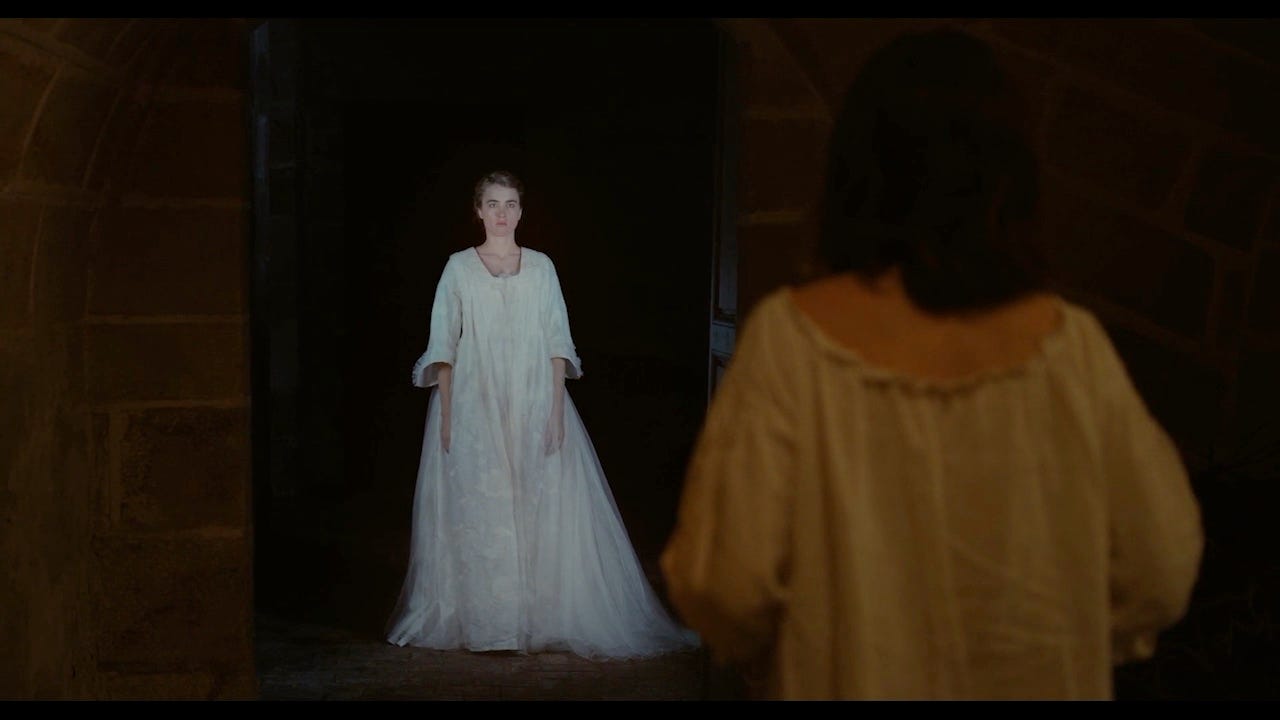PORTRAIT OF A LADY ON FIRE is a ghost story
How does using the visual language of gothic horror create a feeling of doomed love?
Portrait of a Lady on Fire (2019) draws on the visual language of gothic horror and ghost movies to tell the story of portrait painter Marianne (Noémie Merlant) and her love affair with Héloïse (Adèle Haenel), an aristocrat. Marianne has been commissioned to paint Héloïse’s portrait so Héloïse can be married off to a Milanese gentleman.
The story is told in hindsight and from Marianne’s perspective. Ghost stories are really about the impact of the past on the present, and Marianne is haunted by her relationship with Héloïse. While Héloïse is haunted by the suicide of her sister, and refuses to be married off. These stylistic choices by director Céline Sciamma reinforce the theme and the emotion.
Let us break down a few moments.
The Old Portrait
In this scene, Marianne finds a previous painter's portrait of Héloïse. It leans into gothic motifs like the dusty sheets and the mysterious object in the mirror — creating a classic “look behind you” beat for the audience.
It uses horror-esque gliding camerawork to puts us inside Marianne's POV while also keeping us seperate from hers.
And how we see Marianne's almost frightened reaction BEFORE we see the creepy portrait.
Meeting Héloïse
In this scene, Marianne is about to meet the reclusive Héloïse for the time.
Again, this riffs on gothic horror cinematic language: The camera — without a subject leading its movement — winds down the stairs, fixated on a hooded figure who doesn't reveal their face or even seem to acknowledge a presence. A figure that leads us, not just Marianna, outside.... possibly to our doom?
Note how the pivot around the foreground chandelier helps us feel the curve of the stairs and adds to the ominousness of the still figure.
The shot continues as we follow the hooded figure outside. Gliding camerawork keeps us inside Marianne's POV, just like in a horror movie.
And we watch, powerless, as Héloïse picks up her pace, seemingly about to throw herself off a cliff. The tension increases. But is then released with her finally looking at Marianne... looking at us.
Quite the meet cute.
The Ghost of Héloïse
Ghost stories are really about the impact of the past on the present.
The strongest gothic horror motif in Portrait Of A Lady On Fire is the ghostly image of Héloïse that haunts Marianne in the final act. We see it three times - two to establish the pattern, the third to subvert it.
The first time we see it the film makes it clear that it is a vision of Héloïse... Marianne turns around and we follow her as she finds Héloïse and rests her head on her shoulder. The tracking shots helping us understand this geography and the ‘real time’ nature of it, so we know that this is a vision.
The second time ‘ghostly’ Héloïse appears is in the room that Marianne just left! Notice how the kitchen falls entirely to black to make the reveal of Héloïse stronger? This looks to be an “electric fade”, that is the fade-to-black is done by turning off lights on set rather than in post. The blue-white light on Héloïse contrasts with the warm-whites of the envrionment, making her feels otherwordly — although the actress was shot on set, in-situ.
The third time reveals the origin of the haunting image. The long follow shot on Marianne gives away to simple, static compositions that accentuate the moment. This is a moment of anagnorisis for the audience. We move from ignorance to knowledge: coming to understand the doomed nature of the illicit love affair between Marianne and Héloïse, and also the structural need for the story to be told in hindsight.
Further Listening
DZ-92: Insightful recognition in powerful endings
Draft Zero Episode 92 looks at anagnorisis in LA LA LAND, INCEPTION, NO COUNTRY FOR OLD MEN and TURNING RED
Draft Zero Episode 94 looks at the use of talismans to track character change wordlessly in THOR: LOVE AND THUNDER, PORTRAIT OF A LADY ON FIRE, and IN THE THE MOOD FOR LOVE.
IMDB
PORTRAIT OF A LADY ON FIRE: Full Cast and Crew



